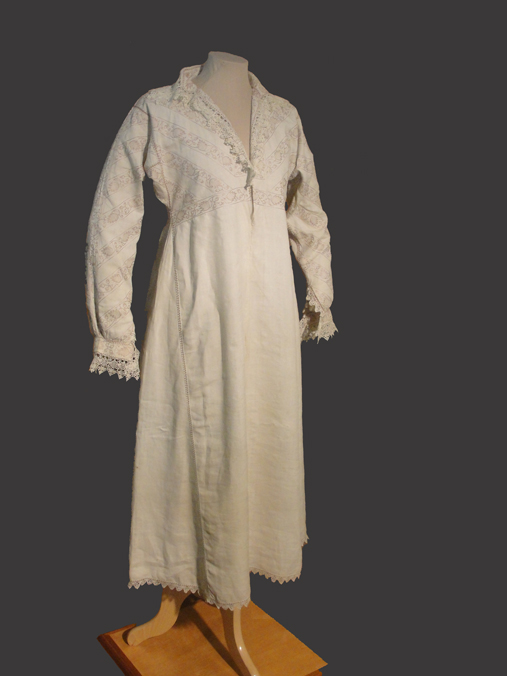A woman's linen smock embroidered with pink silk, and edged in bobbin lace, c.1605-1615. Given to the College in 1913 by Revd W.E. Lush of Auckland, NZ. It had been in his mother's family for generations, and the (unsubstantiated) tradition was that it had belonged to Dorothy Wadham.
The Wadham Smock
[The following extract is taken from Gilian Dye's book The Isham samples and other linen edgings. Book 2. Sixteenth & seventeenth century lace (Glasgow: Cleveden Press, 2012), ISBN 9780955322341, pp.40-43. Reproduced by kind permission of the author and publisher]
In Wadham College, Oxford, there is a lace-edged linen smock that possibly belonged to the College's founder, Lady Dorothy Wadham. There is no provenance directly linking the smock to Lady Dorothy, however it is of the right period (around 1610) and it seems unlikely that such an impressive piece of clothing should have come into the care of the college unless there was some connection. The smock is almost certainly English, embroidered in pink silk, like that of the smock on p.38, with a lace edging around the hem, a wider one round sleeve and neck openings and a wide insertion across the back of the neck.
The smock is beautifully conserved and when I saw it it was displayed in a large glass case in the Wadham library bookstore (36); this of course made photography and measurements difficult, so I was pleased that I was able to use Janet Arnold's measurements in Patters of Fashion 4 for my reconstruction attempts.
It was this book that had alerted me to the existence of the Wadham smock and before visitng the college I tried working the lace on the hem (37a). As soon as I saw the actual lace (37b) I realised that although the proptortions are about right, the headside of the original is considerably more complicated.
After some trial and error I settled on the method shown in 37f as a workable way of getting the right effect for the headside, together with a long plait (ctctc x 7) at the point. With the phtotographs I have it is not possible to see the exact working of the solid areas between the scallops; the working shown in 37e is a possible solution.
Sample worked with 12 Bockens linen 80/2.
The wider edging on the cuff (38) requires 24 pairs. Unlike the pink and white edging on p.39, all the threads for the wheels come from the central crossing. This contributes to the relatively large number of pairs needed.
Working notes:
Between the scallops one plait is taken from the solid area to the left and back; another goes to the right where a pair is exchanged at the footside before the plait returns. The plaits going through the centre of the scallop start and finish at the footside. Work tight plaits of ctc tc tc tc with the two pairs that go between the outer and inner wheels. Short lengths of 3-pair plaits are needed towards the point of the scallop. A pin at the central crossing is helpful to keep pairs in order; if using pins on the inside loops of the scallop, take them out as soon as possible - working plenty of stitches in each plait is a better way of keeping the shape.
There are remarkable similarities between the lace in 39 and Rosemary Shepherd's reconstruction of the Batavia lace (40) (see also p.78 of their Early lace workbook). The original of the Batavia lace was recovered (along with some bobbins) from the wreck of the Dutch East Indies ship Batavia, which went down off the coast of Austtralia in 1629. The lace must therefore date from before 1629, and there is a good chance that it is Dutch or Flemish. Was the Wadham lace also Flemish? Or perhaps, as there were good trade links between the two countries, both edgings could be English? Or perhaps they were just developed from a common source?
